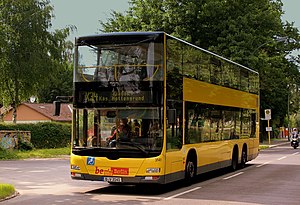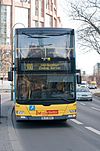Loading AI tools
Overview of the bus transport in Berlin From Wikipedia, the free encyclopedia
Bus transport is the oldest public transport service in Berlin, the capital city of Germany, having been introduced in 1846. Since 1929, services have been operated by the Berlin Transport Company (German: Berliner Verkehrsbetriebe, BVG), although during the Cold War-era division of the city they operated in West Berlin only. In East Berlin the public transport agency split off from the BVG and rebranded as BVB, operating the buses in the Soviet sector of Berlin.
| Bus transport in Berlin | |
|---|---|
 | |
 MAN Lion's City DD double decker bus | |
| Overview | |
| Locale | Berlin, Germany |
| Transit type | Public bus transport |
| Number of lines | 152 (+49 night lines) |
| Number of stations | 6.589 |
| Website | https://www.bvg.de/en |
| Operation | |
| Began operation | 1846 |
| Operator(s) | Berliner Verkehrsbetriebe |
| Number of vehicles | 1,550 |
| Technical | |
| System length | 1,798 km (1,117 mi) |






Currently, the BVG's fleet consists of 1,550 vehicles, which cover 300,000 kilometres per day.
As many transit operators around the world, the BVG has set a goal to have their entire fleet running without emissions until the year 2030. For this reason the number of battery electric busses in Berlin is steadily rising.[1]
30 October 1846 saw the first bus services from the Concessionierte Berliner Omnibus-Compagnie. In 1868, a new company was created, the ABOAG (Allgemeine Berliner Omnibus Aktien Gesellschaft) which on 1 January 1929 merged with other Berlin public transport companies to create the BVG.
After the opening of the Berlin Wall, the transport companies were no longer able to cope with the traffic, and so once again, solo buses by other transport companies and 100 hired coaches were used. The 3-digit numbering system was unified and implemented on 2 June 1991, just before the reunification of BVG in 1 January 1992.
Normal bus routes (![]() )[2] make up most of the network and consist of around 120 lines, numbered from 100 to 399. The most famous line is the 100, which serves the tourist route from Alexanderplatz to the Zoological Garden passing many of Berlin's sights. The suburban buses, operating outside Berlin and not managed by BVG, are included in the tariff area of Berlin public transport.
)[2] make up most of the network and consist of around 120 lines, numbered from 100 to 399. The most famous line is the 100, which serves the tourist route from Alexanderplatz to the Zoological Garden passing many of Berlin's sights. The suburban buses, operating outside Berlin and not managed by BVG, are included in the tariff area of Berlin public transport.
Each bus line has a 3-digit number. The second digit indicates the borough in which the line runs:
As for the MetroTram lines, there are 19 MetroBus (![]() )[3] lines, each running at least every 10 minutes with a 24-hour service. Unlike the other bus lines, they were shown on many tramway maps and on some railway maps of the city, in their early existence.
)[3] lines, each running at least every 10 minutes with a 24-hour service. Unlike the other bus lines, they were shown on many tramway maps and on some railway maps of the city, in their early existence.
The MetroBus routes are:[4]
The express buses (![]() )[5] are 13 rapid lines, mainly used to reach the airports or linking the suburbs to the city centre, with far fewer stops. The most famous route is the former TXL bus line (Tegel Airport – Alexanderplatz), which ceased service after the closure of Tegel airport.
)[5] are 13 rapid lines, mainly used to reach the airports or linking the suburbs to the city centre, with far fewer stops. The most famous route is the former TXL bus line (Tegel Airport – Alexanderplatz), which ceased service after the closure of Tegel airport.
The ExpressBus routes are:[4]
The night buses (N),[6] consisting of 40 lines and other 9 lines to substitute (from N1 to N9) the U-Bahn (except at weekends). The N7X bus line is an express line, only serving stations with higher demand on its journey, the line can also only be taken in one direction towards the airport. The other lines serve suburban neighbourhoods not served by any public service running in daytime.
The aforementioned U-Bahn substitution night bus lines are:[4]

Apart from the service buses managed by BVG and other local companies, in the city there are hundreds of private tourist coaches. The main coach bus station of Berlin is the Zentraler Omnibusbahnhof Berlin ("Central Omnibus Station"), also known as ZOB.[7] It is located in Charlottenburg-Wilmersdorf and linked to the stations of Kaiserdamm (U-Bahn) and Messe Nord/ICC[8] (S-Bahn).
On 18 February 2011 MR Software released OMSI – The Bus Simulator (also known as OMSI – Der Omnibussimulator) for Windows. It is a bus simulator set in the late 1980s in West Berlin that features the MAN SD200 and MAN SD202 double-decker buses with a complex set of functions and made in various years. The player operates these buses along line 92 (now M37) that served the Staaken, Wilhelmstadt, Altstadt, and Falkenhagener Feld localities in the borough of Spandau. On 11 December 2013, MR Software released OMSI 2 – The Bus Simulator for Windows, the sequel to OMSI – The Bus Simulator. It features the MAN NL202 and the MAN NG272 in addition to the buses featured in OMSI (MAN SD200/SD202). The player can enjoy the bus lines 5 (now 130), 92 (now M37) and other add-ons which is community developed. It is sold on Aerosoft, Steam and Halycon.
As of 2023, the BVG bus fleet consists of 1550 buses.
| Quantity | Manufacturer | Type | Passengers | Length | Notes | Photo |
|---|---|---|---|---|---|---|
| 108 | VDL | EN15 (Citea LLE-120) | 100 | 12 m | In operation since 2015. |  |
| 46 | VDL | EN18 (Citea LLE-120) | 100 | 12 m | In operation since 2018. |  |
| 48 | Mercedes-Benz | EN18 (Citaro C2) | 106 | 12 m | In operation since 2018. |  |
| 23 | Mercedes-Benz | EN19 (Citaro C2) | 106 | 12 m | In operation since 2019. |  |
| 57 | Mercedes-Benz | EN20 (Citaro C2) | 106 | 12 m | In operation since 2020. |  |
| 40 | Mercedes-Benz | EN21 (Citaro C2) | 106 | 12 m | In operation since 2021. |  |
| 1 | Solaris | EE18 (Urbino 12 electric) | 90 | 12 m | In operation since 2018. |  |
| 15 | Solaris | EE19 (Urbino 12 electric) | 90 | 12 m | In operation since 2019. | |
| 15 | Mercedes-Benz | EE19 (eCitaro) | 88 | 12 m | In operation since 2019. |  |
| 90 | Solaris | EE20 (Urbino 12 electric) | 90 | 12 m | In operation since 2020. |  |
| >90 | Ebusco | EE22 (Ebusco 2.2) | 90 | 12 m | In operation since 2022.
Currently in delivery. |
 |
| 475 | Total | |||||
| Quantity | Manufacturer | Type | Passengers | Length | Notes | Photo |
|---|---|---|---|---|---|---|
| 70[9] | Scania | GN14 (Citywide LFA) | 150 | 18 m | In operation since 2014. |  |
| 40 | Scania | GN15 (Citywide LFA) | 150 | 18 m | In operation since 2015. |  |
| 179 | Scania | GN16 (Citywide LFA) | 150 | 18 m | In operation since 2016. |  |
| 67 | Scania | GN18 (Citywide LFA) | 150 | 18 m | In operation since 2018. |  |
| 100 | Mercedes-Benz | GN18 (Citaro C2G) | 163 | 18 m | In operation since 2018. |  |
| 40 | Mercedes-Benz | GN19 (Citaro C2G) | 163 | 18 m | In operation since 2019. |  |
| 165 | Mercedes-Benz | GN20 (Citaro C2G) | 163 | 18 m | In operation since 2020. | |
| 17 | Solaris | GE20 (Urbino 18 electric) | 150 | 18 m | In operation since 2020. |  |
| 251 | Mercedes-Benz | GN21 (Citaro C2G) | 163 | 18 m | In operation since 2021. |  |
| 929 | Total | |||||
| Quantity | Manufacturer | Type | Passengers | Length | Notes | Photo |
|---|---|---|---|---|---|---|
| 7 | MAN | DL07 (Lion's City DD) | 110 | 13.7 m | In operation since 2007. |  |
| 10 | MAN | DL08 (Lion's City DD) | 110 | 13.7 m | In operation since 2008. |  |
| 1 | MAN | DL09 (Lion's City DD) | 110 | 13.7 m | In operation since 2009. |  |
| 1 | Scania | DN15 (Citywide LFDD) | 88 | 10.9 m | Discontinued in 2021.
Only for driving tests. |
 |
| 2 | Alexander Dennis | DL20 (Alexander Dennis Enviro500 MMC) | 80 seated | 13.8m | In operation since 2021. |  |
| >198 | Alexander Dennis | DL20 (Alexander Dennis Enviro500 MMC) | 80 seated | 13.8 m | In operation since 2021.
Currently in delivery. | |
| 145 | Total | |||||
Seamless Wikipedia browsing. On steroids.
Every time you click a link to Wikipedia, Wiktionary or Wikiquote in your browser's search results, it will show the modern Wikiwand interface.
Wikiwand extension is a five stars, simple, with minimum permission required to keep your browsing private, safe and transparent.